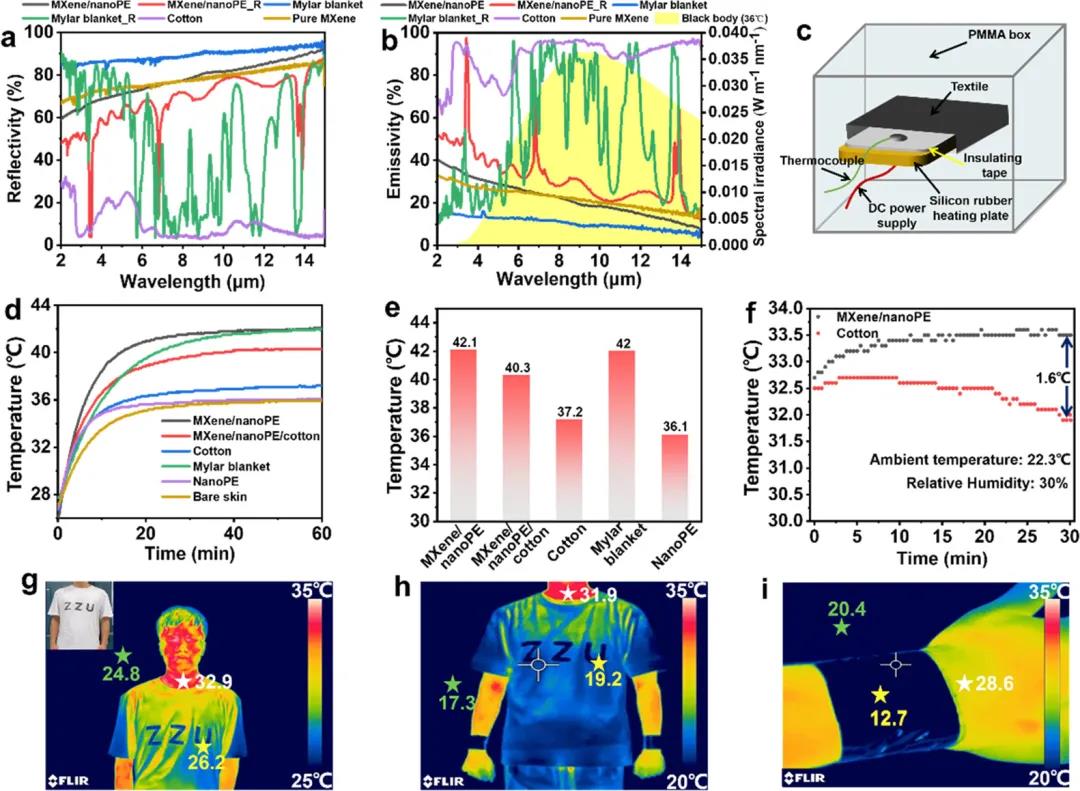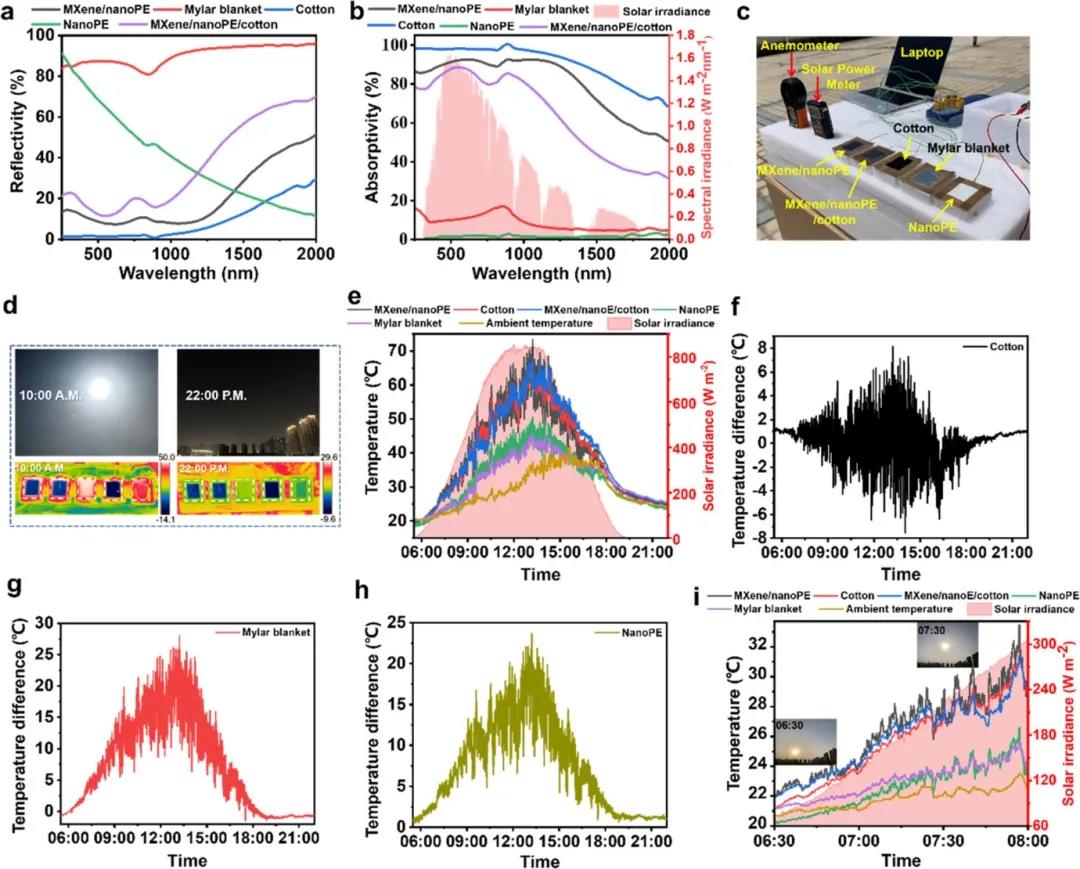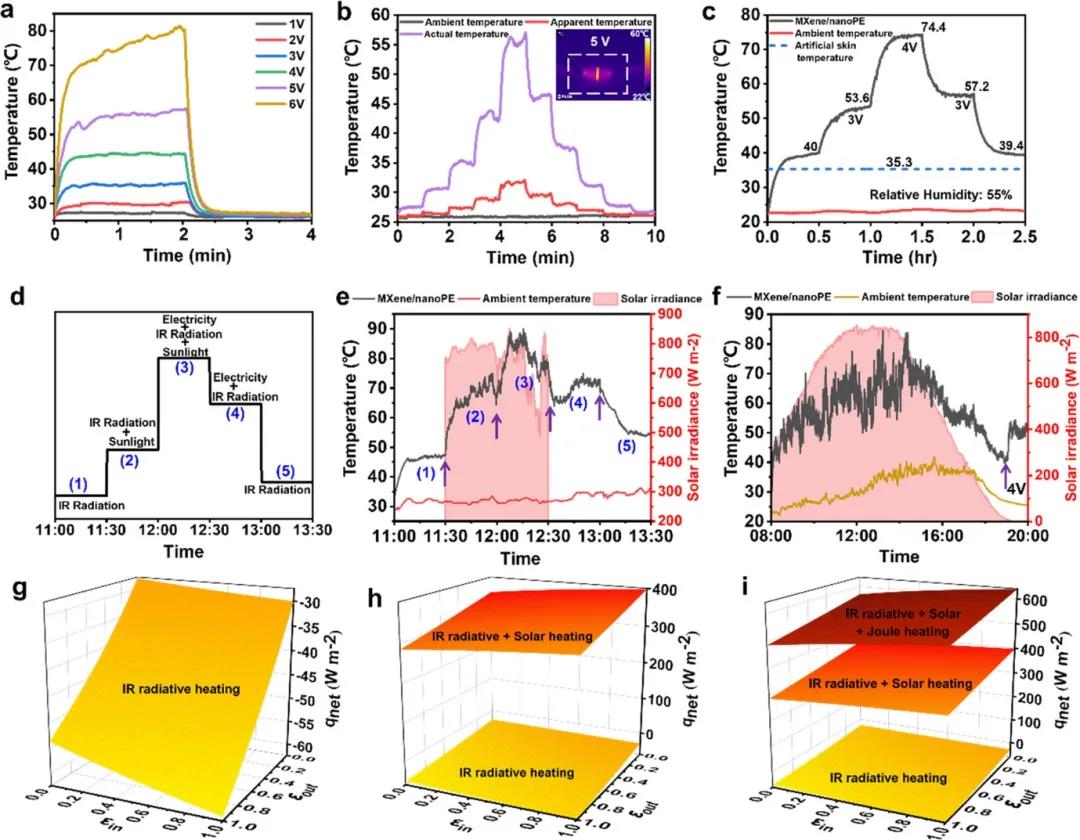
hotline:
17715390137
Tel/Wechat:
18101240246 (Technology)
0512-68565571
Email:mxenes@163.com (Sales Engineer)bkxc.bonnie@gmail.com
Scan the code to follow or search the official account on WeChat:
2D Materials Fronrier After paying attention,
click on the lower right corner to contact us,
Enter enterprise WeChat.
Professional Services Online

Under normal circumstances, about 50% of the body s heat loss is achieved by radiating infrared rays. To reduce the infrared radiation loss, an effective strategy is to control the mid infrared emissivity of our textiles and clothing, so as to realize the passive radiation heating (PRH) of human body. Compared with the traditional heating strategy, PRH has the advantages of no energy consumption, more accurate and effective. For example, in 2017, Professor Cui Yi s research group invented a magic "cloth" - human body radiant heating / cooling dual-mode fabric, which can adjust the amount of radiation without any external energy input, and has the effect of keeping warm in front and cooling in back.
Although the intelligent nano textile has a high mid infrared emissivity, the thermal radiation generated by human body can be easily sent to the cold outer space through it (Fig. 1a). Therefore, in the outdoor environment, the maximum thermal insulation capacity of PRH is limited, which makes it difficult to deal with the complex weather environment alone. Especially when the day and night (day / night) and weather (sunny / cloudy) change greatly, it is difficult to achieve accurate heating of human body. Therefore, the development of materials and systems that can accurately heat the human body in an efficient and energy-saving way is very important to alleviate the energy crisis and global warming.

Figure 1. Heat transfer schematic diagram of human skin covered with traditional textiles and mxene / nanope textiles, and preparation process and characterization of mxene / nanope textiles.
In order to solve the above problems, Professor Wang Wanjie and Associate Professor Wang Jianfeng of Zhengzhou University reported an efficient and energy-saving all-weather personal precision heating strategy: by coating a thin ti3c2tx mxene coating (1 μ m) Three heating modes, PRH, energy-saving solar heating and compensatory Joule heating, were successfully integrated into the wearable mxene / nanope textiles (12 μ m) In the system (Figure 1b).
Thanks to the low mid infrared emissivity, high light heat conversion efficiency and electrical conductivity of mxene, mxene / nanope textiles not only have excellent indoor PRH performance, but also show excellent active solar heating (73.5%) ° C) And Joule heating (55 ° C. 5 V). It is impressive that the three heating modes can be easily switched or any combination, so that mxene / nanope textiles can accurately heat the human body all day in a variety of scenarios. In addition, the obtained mxene / nanope textiles also show excellent wear resistance, including mechanical strength, air permeability, wind resistance, flame retardancy, electromagnetic interference shielding, antibacterial properties, quick drying and so on. It is an ideal candidate material and system for human body precision thermal management in the future. The research results are entitled ti3c2tx mxene decomposed nanogroups polyethylene textile for passive and active personal precision heating and published in ACS Nano, a famous journal in the field of nanomaterials.
Interpretation of key points
Preparation and morphology characterization of 01 mxene / nanope textiles
Preparation process (Fig. 1c): the researchers first polymerized a layer of polydopamine (PDA) on the surface of nanope fabric to form a hydrophilic surface; Then, mxene / nanope textiles can be prepared by simply spraying mxene solution on the surface of PDA modified nanope fabrics. This method is simple and suitable for large-scale preparation of mxene / nanope textiles (Fig. 1d-e).
Morphology characteristics: SEM results show that nanope has a nano porous structure with pore size ranging from 50 to 1000 nm (Fig. 1F). After the spraying process, mxene nanosheets were uniformly coated on the surface of nanope (Fig. 1g) and showed high hydrophilicity. In addition, the thickness of mxene coating is about 1 μ m. The total thickness of mxene / nanope fabric is about 12 μ m。 02 mxene / nanope textile combines passive radiation heating, solar heating and Joule heating, which can be freely switched or integrated to provide accurate heating for human body in all directions
Passive radiation heating ability: it is found that mxene has low mid infrared emissivity, and the mxene side and nanope side of mxene / nanope textiles are 7-14 μ The average mid infrared spectral emissivity at M is 0.176 and 0.267, which is much lower than that of traditional cotton textiles (0.931). At the same time, with the thickness up to 576 μ Compared with traditional cotton fabric, it is as thin as 12 μ The m-thick mxene / nanope fabric showed excellent indoor PRH performance, and the temperature increased by 4.9% ° C。

Figure 2. Passive radiation heating capability of mxene / nanope textiles
Solar heating performance: due to the high solar absorption and light heat conversion capacity of mxene, no matter in sunny days, or at night or cloudy days, mxene / nanope textiles show better thermal retention capacity than other textiles (Fig. 3). Even in cloudy days, the peak temperature of mxene / nanope textiles can reach 54.0 ℃ ° C. It is 5.7, 18.2 and 16.5 times higher than cotton, Mylar blanket and nanope textiles, respectively ° C。 This fully shows that mxene / nanope textiles can accurately heat the human body in indoor and outdoor, day and night, sunny and cloudy days without energy input or energy saving.

Figure 3. Solar heating performance of mxene / nanope textiles.
Joule heating capacity: in addition, mxene / nanope textiles also have a high conductivity of 2800 SM-1, showing excellent Joule heating capacity, enabling them to cope with cold winter or rainy days. It is found that the temperature of mxene / nanope textiles reaches 27, 30, 35, 43, 55 and 83 in a short time after applying 1, 2, 3, 4, 5 and 6 V safe voltage ° C. It shows fast thermal response and efficient electrothermal conversion. In addition, the Joule heating performance of mxene / nanope textiles is sensitive and adjustable, and can be easily switched from 1 to 5 V or from 5 to 1 V to obtain the required heating temperature (Fig. 4b).

Figure 4. Joule heating properties of mxene / nanope textiles.
It is impressive that these three heating modes can be easily switched or any combination, enabling mxene / nanpe textiles to accurately heat the human body in indoor and outdoor, day and night, sunny and cloudy scenes.
03 mxene / nanope textile has excellent wear resistance to meet the needs of practical use
In order to explore the actual use of mxene / nanope textiles, the researchers evaluated their wear resistance. As shown in Fig. 5a, mxene / nanope has excellent air permeability (2.22 mgcm-1 h-1), which is only slightly lower than that of cotton (2.34 mgcm-1 h-1) and much higher than that of commercial Mylar blanket (0.27 MGCM – 1 h-1); In the case of windproof performance, the permeability of mxene / nanope fabric is equivalent to Mylar blanket film (Fig. 5b), which can prevent wind from coming in and taking away heat; In terms of mechanical strength, mxene / nanope textiles can withstand a tensile force of 54 n (Fig. 5C), which can meet the actual use.
At the same time, mxene / nanope textiles have fast drying characteristics: under the condition of natural wind, mxene / nanope textiles extracted from water can completely dry in 6 minutes, much faster than cotton textiles (Fig. 5e). In addition, the high conductivity of mxene / nanope textiles makes them have excellent electromagnetic interference (EMI) shielding performance (Fig. 5F), which can protect human beings from the risk of electromagnetic radiation in daily life. In addition, mxene / nanope textiles also show excellent flame retardancy (Fig. 5e) and antibacterial properties (Fig. 5H).

Figure 5. Wearability of mxene / nanpe textiles, including mechanical strength, air permeability, windproof, flame retardancy, electromagnetic interference shielding, antibacterial properties, etc.
In a word, mxene coating gives mxene / nanpe textiles three heating modes integration and excellent wearability, including mechanical strength, air permeability, wind resistance, flame retardancy, electromagnetic interference shielding, antibacterial property, rapid drying, etc., making it an ideal candidate for personal precision thermal management in the future.
This information is from the Internet for academic exchange only. If there is any infringement, please contact us to delete it immediately

| Reminder: Beijing Beike New Material Technology Co., Ltd. supplies products only for scientific research, not for humans |
| All rights reserved © 2019 beijing beike new material Technology Co., Ltd 京ICP备16054715-2号 |